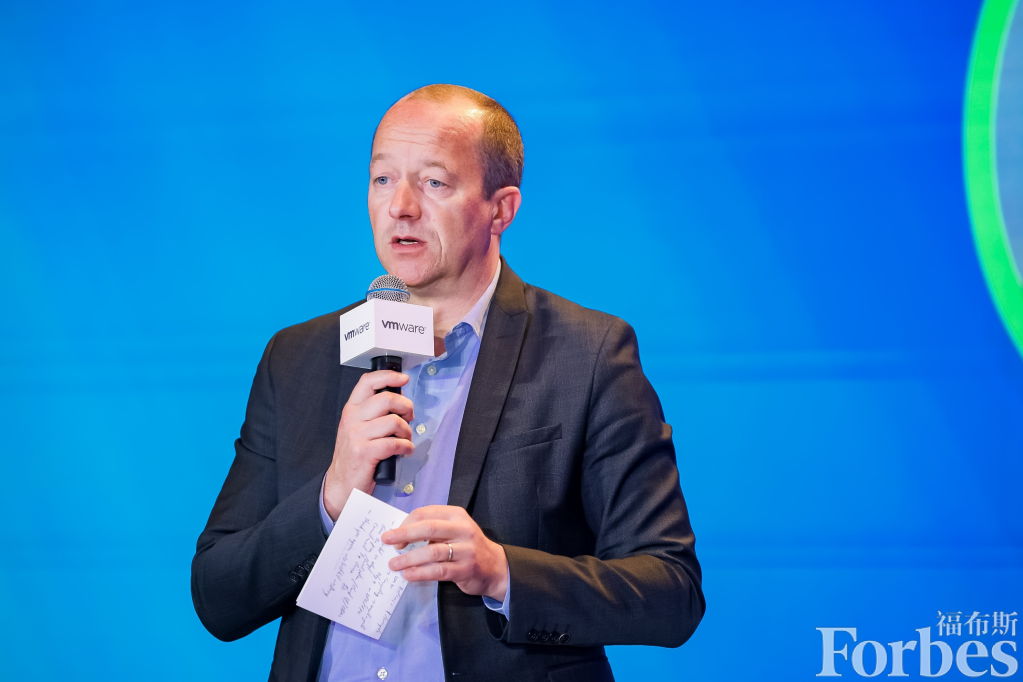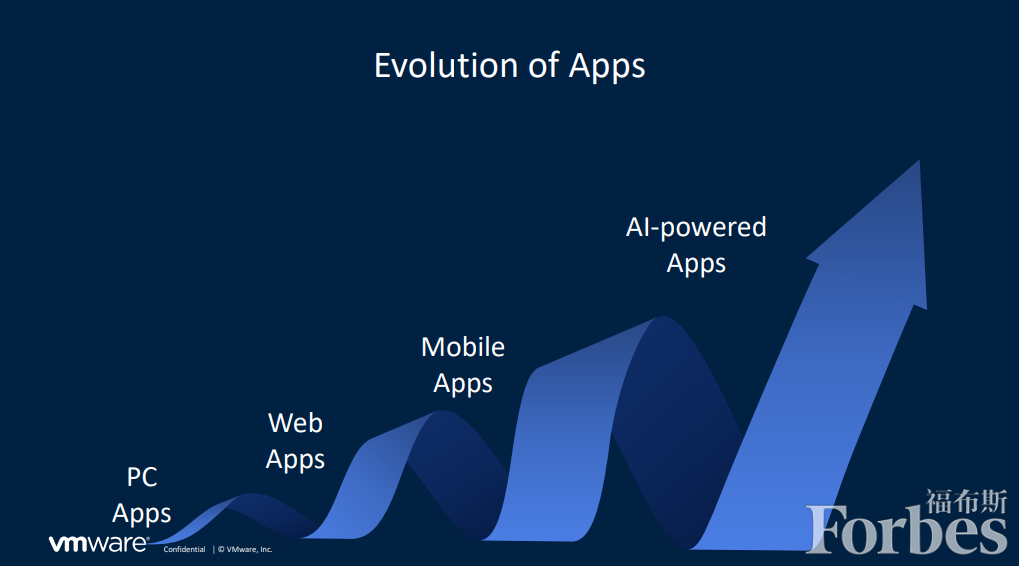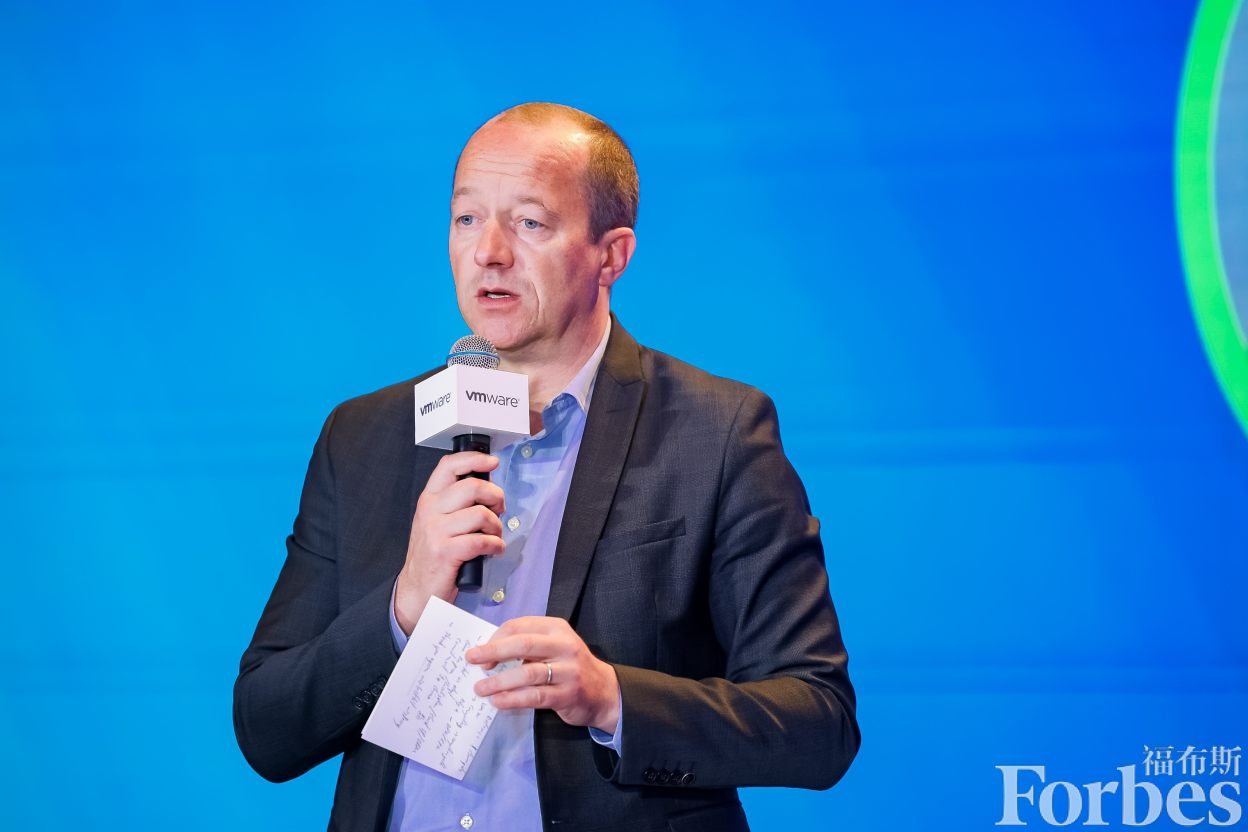(Chinese version is below)
Source from Forbes China, by Hongming Shao
About First Impressions of China's Digital Transformation from the MNC Executive
The airport and the high-speed railway are back to their usual busy schedules after the pandemic control has been lifted. At the same time, more “foreign faces” are seen among travelers, and these two transport hubs have become another important window into China for them.
It was the first visit to China for Sylvain Cazard, Senior Vice President and General Manager, Asia Pacific and Japan, VMware. Although only five days, Sylvain had a jammed-packed schedule. He met with many partners, customers and colleagues, visited the Forbidden City, climbed the Great Wall, ate Peking Duck, and favored the butterfly pastry of Shanghai.
When it came to his first impressions on China, two examples he cited without thinking were the airport and the high-speed railway. What impressed him most, however, was China's digital transformation.
"Beijing Capital Airport is huge and modern, and also takes full advantage of digital tools to deliver an excellent digital experience to passengers," said Sylvain, who was born in France, one of the birthplaces of the high-speed railway. What excited him during the trip was not only the average speed of the high-speed railway over 300km/h, but the fact that almost every passenger in the cabin was using a smartphone or tablet in the entire journey, showing the rapid pace of digital construction in China.

Sylvain has worked as vice president for Central EMEA. Now he is based in Singapore, responsible for VMware's business and strategy in Asia Pacific and Japan. He is adept in executing go-to-market strategy across a multi-product and multi-cloud platform supporting digital transformation of enterprises. (Note: Multi-cloud refers to enterprises using the services of multiple different cloud service providers.)
First Impressions on China
According to Sylvain, China exhibits both differences and similarities when compared to other countries around the world. "First, the scale of Chinese cities is unparalleled and unmatched by other nations. Second, China has already seen a high level of modernization that is close to Japan, South Korea and some European countries.”
When exchanging with organizations, Sylvain found that Chinese companies have large-scale operations and are technologically mature, while digital applications have evolved rapidly here. However, he admitted that despite its rapid technological development, China still has a gap to the highest level.
"'Cloud computing is not an endpoint, but a way to consume computing power." He believes that what customers need is a hybrid model that hosts the modern platforms owned by customers while connecting local cloud platforms. Customers need the ability to connect them together for better outcomes. The demand for computing power in China is high as the country is under digital transformation. Now Chinese companies can build a strong ecosystem and are significantly accelerating digital transformation.
Sylvain reiterates the vastness of China. For instance, with many factories in different cities and regions, edge computing is deployed in many places, such as data centers. Another notable characteristic is the presence of a significant number of local cloud providers within China's ecosystem, including Alibaba Cloud, Tencent Cloud, JD Cloud, and more. This unique state of a multi-cloud ecosystem is specific to China.
In addition, many Chinese companies currently have a strong desire to expand their businesses overseas, seeking opportunities in regions such as the Asia-Pacific, Europe, and Africa. They rely on the respective ecosystems and clouds to support their operations in these locations. On the other hand, many foreign companies need to keep working with local cloud providers as they are trying to enter the Chinese market.
“China has not only a domestic multi-cloud ecosystem, but also a broader multi-cloud system on a global scale.” Sylvain described the Chinese market in his eyes in one sentence.
“Each country has its own characteristics. We have got consistent feedback in our conversations with customers worldwide. While there may be variations in technological maturity and ecosystem across different countries or markets, we discovered commonalities during discussions with our customers. The topics we typically explore revolve around the modernization of infrastructure, maximizing the utilization of cloud platforms, and ensuring security." said Sylvain.
In fact, all countries or markets have in common that multi-cloud is an ecosystem used to connect all clouds. So not only China but also other countries or markets create an ecosystem of clouds to bring together many cloud providers.
Embracing a New Strategy: Offense and Defense
"We are now in a world of cloud computing," Sylvain shared some of his thoughts and the new trends from the exchanges with CIOs in the Asia Pacific region and during the trip to China.
During the pandemic, many organizations migrated to the cloud and accelerated their digital transformation. However, as the global economy experiences a slowdown after the pandemic, many CIOs have expressed a shift in focus towards a dual strategy of offense and defense, rather than continuing to drive digital transformation and innovation. In addition, they are more cost-sensitive under the multiple pressures such as security and sovereignty. "These CIOs have told us that they must now adopt a strategy of balance, simultaneously engaging in offensive and defensive measures," Sylvain remarked.
Sylvain mentioned the new concept of Cloud Smart, which combines solutions such as hybrid and multi-cloud platforms to help customers play offense and defense. He said that Cloud First, as it was often called in the past, was designed to prioritize migration to the cloud. Cloud Smart was also designed to accelerate enterprises’ migration to the cloud and deployment of digital applications while helping modernize their devices to improve costs and efficiency. In addition, Cloud Smart can enhance the security and sovereignty of data through innovative technological means.

Another trend is that AI will drive the next wave of application innovation. Sylvain cited four stages in the evolution of applications over the four decades, from PCs to the Internet and mobile network and to AI-powered ones today. The current rise of generative AI represented by ChatGPT is in line with the fourth stage.
"With the advent of new-generation CPUs, we believe that domain-specific computing power will emerge, which means computing power will be specialized to manage even larger volumes of data," Sylvain said. “These data can be managed efficiently whether it is on the cloud or in a customer's data center, factory or shop.”
"However, the complexity and difficulty of data management for different locations will grow, so VMware will help customers simplify this, make it more manageable and deliver it to them in a cost-controlled way," said Sylvain.
The future will see dedicated generative AI models emerging in many industries and segments. To meet the requirement for computing power, the corresponding CPUs, networking, storage and other hardware will be constantly updated. VMware is actively working with partners like Lenovo and NVIDIA, leveraging their strengths in hardware to enhance virtualization for the future explosion of generative AI applications.
"VMware is a cloud platform and also a computing platform powered by cloud technology," Sylvain emphasized. He highlighted that without virtualization technology, there would be no cloud. Many years ago, VMware began utilizing artificial intelligence technologies, enabling them to build an intelligent and automated platform. This platform offers intelligent features such as automatic detection of potential security risks and centralized computational capabilities.
Increasing Investment in the Local Ecosystem
Although it was Sylvain's first visit to China, he expressed great satisfaction with VMware's business development in the Chinese market. "We've been deeply involved in the Chinese market for more than a decade and our technology is well received by many of our customers," he said. To support R&D for Chinese customers, VMware has established R&D teams in Beijing and Shanghai. It is also increasing its investment in the local ecosystem in China.
Taking Lenovo as an example, Sylvain went on that VMware has been working with Lenovo for more than a decade. To further expand the multi-dimensional strategic partnership, their initiatives will include strengthening local R&D and joint go-to-market activities that accelerate, data center, multi-cloud and edge computing, and help customers transition to subscription-based services.
Barry Chen, Vice President and General Manager, Greater China, VMware, shared relevant cases in the automotive industry. VMware has entered all levels of the automotive-related supply chain in China. Its solutions can be applied not only to IT operations, but also to engineering projects and production lines to enable data intelligence collection and other functions at edge.
Last year, VMware partnered with Alibaba Cloud to launch Alibaba Cloud VMware Service (ACVS), which can be applied across industry chains allowing customers to easily migrate their business or products to Alibaba Cloud without any modifications. Previously, similar migrations led to server disruptions and required redevelopment, which was complex and cumbersome.
In terms of VMware's business model, Sylvain explained that VMware adopts a unified model around the world, but unlike traditional SaaS and subscription-based models, the delivery is left to partners. For example, VMware embeds its solutions or products into cloud services such as Alibaba Cloud, AWS (Amazon Web Services) and Microsoft Azure, and sells them to customers through partners.
Virtualization Drives Sustainability
When discussing sustainable development, Sylvain drew a diagram to illustrate his point. He explained that as the volume of applications and users in the upper layers continues to grow, the computing power at the bottom must grow significantly. At the same time, the digital infrastructure is forced to undergo frequent updates.
“The ideal state is to achieve higher computational power while maintaining the same level of carbon dioxide emissions." According to him, the first step in virtualization is the consolidation of resources, leveraging one server to achieve the performance and functionality of multiple servers. This principle applies to networking and storage as well. The fundamental purpose is to reduce hardware, energy consumption, and cooling requirements. Additionally, adopting more modern data centers and increasing the utilization of renewable energy sources can enable cloud providers to make more efficient use of computational resources. Nowadays, many customers are inclined towards cloud platforms with lower energy consumption when migrating to the cloud. Therefore, virtualization can produce more with less in terms of resource utilization.
Sylvain mentioned a recent buzzword, Telco Cloud. He pointed out that the telecommunications sector is actually a major energy consumer - switches, signal towers, network devices and the like are all heavy energy consumers. For example, SoftBank and Vodafone are using VMware's virtualization products to develop Telco Cloud and 5G platforms. These platforms incorporate technologies and applications such as virtualization and cloud platforms to reduce the need for computing power and therefore energy consumption. As a result, even the increase in demands for networking, connectivity, storage and computing power driven by more advanced technologies will not lead to a rise in CO2 emissions. Generative AI will require massive computing power and thus consume huge amount of energy. Pairing technologies like virtualization with next-generation CPUs will not only improve efficiency, but also reduce hardware usage for lower CO2 emissions.
"VMware is celebrating its 25th anniversary this year. We have been going through all stages of technological advancement, and always holding our core values of Tech for Good, including sustainability. Regardless of how technology evolves, efforts will be made to ensure that carbon dioxide emissions remain within a manageable range and do not have a detrimental impact on the planet," said Sylvain.
Finally, on the progress of Broadcom's acquisition of VMware, Sylvain commented: "All information is public and all regulators have their own procedures and processes in place. VMware is highly confident that the transaction will be completed by the end of Broadcom's fiscal year, which is in October.”
VMware Sylvain Cazard:新AI时代,CIO如何攻守兼备
我们与跨国公司高管聊了聊,中国数字化建设的“初印象”
文章来源于《福布斯中国》,作者邵鸿明
疫情防控放开后,机场和高铁又恢复了往日的繁忙。同时,旅客中多了不少外国面孔,这两大交通枢纽成为他们了解中国的又一重要窗口。
这是VMware亚太及日本地区高级副总裁兼总经理 Sylvain Cazard第一次来中国。虽然只有5天时间,但Sylvain的日程安排满满当当。他见了不少合作伙伴、客户和同事,参观了故宫,爬了长城,吃了北京烤鸭,还对上海的蝴蝶酥情有独钟。
谈到对中国的第一印象,他不假思索地列举了两个例子,就是机场和高铁。不过,让他印象最深的是中国的数字化建设。
“北京首都机场不仅庞大、现代化,而且充分地利用了数字化工具,为乘客提供了非常好的数字化体验。” Sylvain说,自己出生在高铁的诞生地之一的法国,此次高铁之旅让他兴奋的不止是超300km/h的平均行驶速度,车厢内几乎每一位乘客全程都在使用智能手机或平板电脑,让他感受到中国数字化建设速度的迅猛。
Sylvain曾在欧洲、中东和非洲中部等地区工作过,目前常驻新加坡,主要负责VMware亚太及日本地区的业务和策略。他擅长跨多个产品和多云平台的上市战略执行,以持续支持企业数字化转型。(注:多云,即Multi-cloud,指企业的业务环境中使用多家不同云计算厂商的服务)
中国的第一印象
在Sylvain看来,中国与世界上其他国家相比,差异性和相似性并存。 “首先,中国城市的规模都非常大,这是其他国家无法相比的。其次,中国的现代化发展水平已经非常高,与日本、韩国以及欧洲一些国家非常相似。”
与企业交流中,Sylvain发现中国企业规模很大,在技术上也已经相当成熟,同时数字化应用已经得到了快速发展。不过,他坦言,虽然中国技术发展的速度很快,但与最高水平仍有一定的差距。
“云计算没有终点,而是一种消费算力的方式。” 他认为,客户需要的是一种混合模式,一方面承载客户所拥有的现代化平台,另一方面连接本地云平台的能力。客户需要将其连接起来的能力,从而达到一个更好的效果。中国市场对算力有着强烈的需求,因为中国正处于数字化建设和转型的进程中,同时中国企业已经拥有建立强大的生态系统的能力,并且正在大大加快数字化建设的进程。
Sylvain再度强调,中国非常庞大。例如,在不同城市、不同地区都有很多工厂,所以很多地方都部署了边缘计算,例如数据中心等。还有另一个特点,中国的生态系统中已经有了大量本土云供应商,包括阿里云、腾讯云、京东云等等,这是中国多云生态系统所独有的现状。
此外,目前大量中国企业都有“出海”的需求,寻求在海外开展业务。无论是亚太、欧洲、非洲等地区,都需要利用相应的生态系统和云计算来支撑自己的业务。另一方面,还有大量外国企业试图进入中国市场,所以也需要与本地的云供应商保持合作。
“首先,中国拥有一个国内的多云生态系统,其次,还拥有一个更广泛的全球范围内的多云系统。” Sylvain用一句描述了他眼中的中国市场的特点。
当然,每个国家都有各自的特点,Sylvain说:“我们与世界各地的客户交流中,得到的反馈都比较一致。在不同国家或市场上,技术成熟度和生态体系都会有所差别,但与我们客户讨论过程中,发现其实都存在相似性。我们需要探讨的方向一般都是基础设施的现代化程度、如何更好地运用云平台以及保障安全等话题。”
事实上,所有国家或市场都有其共通性,多云是一个生态系统,用来连接所有的云。所以,不仅是中国,其他国家或市场都会打造一个云的生态系统,以汇聚大量的云供应商和云厂商。
攻守兼备的新策略
“我们现在已经身处一个云计算的世界里。” Sylvain分享了自己与亚太地区以及此次中国之行中与CIO(首席信息官)之间交流的一些感想以及新趋势。
疫情期间,很多企业都涌向了云,并加快自身的数字化建设。而疫情之后,全球经济增长开始放缓。不少CIO表示,他们现在推动数字化转型和创新的同时,更注重防守。另一方面,他们对成本更敏感了,同时还面临安全、主权等多方面压力。“这些CIO告诉我们,现在他们必须采取一种攻守兼备的方式开展工作。”
Sylvain提到了“云智能”(Cloud Smart)这一新概念,其融合混合云平台和多云平台等解决方案,可以帮助客户实现攻守兼备。他表示,过去往往称其为“云优先”,目的就是优先“上云”,而云智能同样是为了加速企业的上云以及数字化应用的部署的同时,还有助于提升企业设备的现代化水平,从而达到降本增效的目的。此外,云智能还可以通过创新的技术手段,增强数据的安全性和主权性。
另一个趋势就是人工智能将推动下一轮应用的革新。Sylvain列举了四十年来应用发展的历程,包括从PC到互联网,再到移动网络,以及如今人工智能驱动的四个阶段。目前,以ChatGPT为代表的生成式AI的兴起,正与第四阶段相契合。
“伴随着新一代CPU的出现,我们相信将来会出现针对某些领域的算力,也就是算力会被专业化,从而能够管理更庞大的海量数据。” Sylvain说,无论这些数据是在云上,还是在客户的数据中心、工厂或者门店里,都可以被有效地管理。
“不过,对于不同地点数据的管理,复杂度和难度也会随之提升,所以VMware会帮助客户简化这一切,使其更便于管理,并以一种成本可控的方式交付给客户。” Sylvain表示。
未来,很多行业以及细分领域会涌现出专用的生成式AI模型。为了满足算力要求,相应的CPU、网络、存储等硬件都将不断被更新。为此,VMware正在积极与合作伙伴进行合作,例如联想、英伟达等,以便借助其硬件上的优势,加强虚拟化技术,为未来生成式AI应用的大爆发做好准备。
“VMware是一个云平台,更是由云技术推动的计算平台。” Sylvain强调,如果没有虚拟化技术,就不可能有任何云。多年以前,VMware就开始使用人工智能技术,所以有能力打造一个智能化、自动化的平台,可以提供自动探测潜在的安全隐患以及自动集中算力等智能化功能。
扩大对中国本土生态体系的投资
虽然第一次来中国,但Sylvain对VMware在中国市场的业务开展相当满意。“我们已经在中国市场深耕十多年了,很多客户对我们的技术都很认可。”他说道,为了支持中国客户的研发,VMware已经在北京和上海设置了研发团队。同时,公司在中国,还在不断扩大在华本土生态体系的投资。
以联想为例,Sylvain继续介绍道,VMware与联想合作已经超过十个年头,为了进一步拓展多维度的战略合作,包括加强本地化研发及联合市场推广、数据中心业务拓展、提升边缘计算方案能力、开拓中国多云市场以及为客户提供订阅式服务等等。
作为大中华区的负责人,VMware全球副总裁、大中华区总裁陈学智分享了汽车行业的相关案例。目前,VMware已经进入国内汽车相关供应链的各个层面,其解决方案不仅可以运用到信息运维上,还可以深入企业的工程项目以及产线,为其边缘侧提供数据智能采集等功能。
去年,VMware与阿里云合作推出了阿里云VMware服务(ACVS,即Alibaba Cloud VMware Service)。该服务可以应用在各个产业链中,客户不需要任何修改,就能便捷地将业务或产品“搬迁”到阿里云上。原本类似的迁移,服务器都必须中断,而且还需要重新开发,相当复杂、繁琐。
对于VMware的商业模式,Sylvain介绍道,公司在世界各地采用是统一的模式,但与传统SaaS和订阅模式不同,是交由合作伙伴来实现交付的。例如,VMware将自己的解决方案或产品嵌入到阿里云、亚马逊AWS(国内称为:亚马逊云科技)、微软Azure等云服务中,并通过合作伙伴来销售给客户。
虚拟化技术助力可持续发展
谈到可持续发展的话题,Sylvain随手画了一张示意图,他说,随着上层的应用和用户量的不断增长,底层的算力也必须大幅增加,同时数字化基础设施也被迫频繁更新。
“最理想的状态是,在相同的二氧化碳排放量的情况下,输出更多的算力。” 他认为,虚拟化技术的第一步就是资源的整合,例如用一台服务器来实现多台服务器的性能和功能,同时网络和存储也是如此。根本的作用就是减少硬件、减少能耗以及减少冷却,同时采取使用更现代化的数据中心并加大可再生能源的利用等手段,让云供应商更有效地利用算力。现在很多客户在上云过程中,也会更高倾向于能耗更少的云平台。所以,虚拟化技术对于资源利用来说,能够达到事半功倍的效果。
Sylvain提到了一个近期热门的话题——电信云。他认为,其实电信行业是能耗大户,诸如交换机、信号塔、网络设备等都会产生大量能耗。例如,目前日本的软银、英国的沃达丰等都采用VMware的虚拟化产品,用以开发电信云和5G平台等。这些平台融合了虚拟化技术和云平台等技术和应用,以减少算力的需求,从而减少能耗。因此,在更多先进技术的推动下,即使网络、连接、存储和算力等需求的增加,也不会带来二氧化碳排放的上升。未来,生成式AI需要巨大的算力支撑,将消耗大量的能耗。通过虚拟化等技术与新一代CPU相配合,不仅能够提升效率,还能减少硬件的使用,达到降低二氧化碳排放的目的。
“今年正逢VMware的25周年,我们经历了科技进步的各个阶段,一直秉承公司的核心价值观,就是让技术为善,可持续发展也包括其中。未来的发展方向是,无论技术如何发展,二氧化碳排放对地球影响都将在可控的范围内。” Sylvain说道。
最后,对于博通收购VMware的进展,Sylvain表示:“一切信息都是公开的,所有监管者都有自己的程序和流程。对于VMware来说,我们非常有信心,相信等到博通今年财年结束的时候,也就是10月份,最终交易肯定能够完成。”
